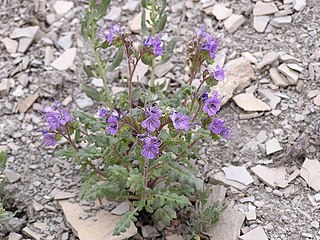
Phacelia crenulata is a species of flowering plant in the borage family, Boraginaceae. Its common names include notch-leaf scorpion-weed, notch-leaved phacelia, cleftleaf wildheliotrope, and heliotrope phacelia. Phacelia crenulata has an antitropical distribution, a type of disjunct distribution where a species exists at comparable latitudes on opposite sides of the equator, but not at the tropics. In North America, it is native to the southwestern United States as far east as Colorado and New Mexico, and Baja California and Sonora in Mexico. In South America, it is native to southern Peru, western Bolivia, and northern Chile.

Diplacus nanus is a species of monkeyflower known by the common name dwarf purple monkeyflower. It is native to California and the Northwestern United States to Montana. It grows in moist habitat, often in bare or disturbed soils. It was formerly known as Mimulus nanus.
Phacelia affinis is a species of flowering plant in the borage family, Boraginaceae, known by the common names limestone phacelia and purple-bell scorpionweed. It is native to the southwestern United States and Baja California and Sonora in Mexico. It can be found in scrub, woodland, forest, and other habitat.

Phacelia breweri is a species of phacelia known by the common name Brewer's phacelia.

Phacelia ciliata is a species of phacelia known by the common name Great Valley phacelia. It is native to California, where it can be found in many of the coastal mountain ranges, the Central Valley, and the Sierra Nevada foothills; its distribution extends into Baja California. It grows in grasslands and low mountain slopes.
Phacelia coerulea is a species of phacelia known by the common name skyblue phacelia. It is native to the California and the Southwestern United States and northern Mexico, where it grows in desert and plateau habitat types, such as scrub and woodland.
Phacelia congdonii is a species of phacelia known by the common name Congdon's phacelia. It is endemic to California, where it grows in the Sierra Nevada foothills and the Transverse Ranges. It is a member of the flora in chaparral, woodland, and other local habitat.

Howellanthus is a monotypic genus of flowering plants in the borage family containing the single species Howellanthus dalesianus, commonly known as Scott Mountain phacelia or Howell's phacelia. Until 2010 the plant was known as Phacelia dalesiana. It is endemic to the southern Klamath Mountains of northern California, including the Scott Mountains for which it is named. It grows in mountain forests and meadows often on serpentine soils.

Phacelia distans is a species of flowering plant in the borage family, Boraginaceae, known by the common names distant phacelia and distant scorpionweed. It is native to the southwestern United States and northwestern Mexico, where it grows in many types of habitat, including forest, woodland, chaparral, grassland, and meadows.

Phacelia greenei is a species of phacelia known by the common name Scott Valley phacelia. It is endemic to the southern Klamath Mountains of far northern California, where it is known only from Scott Valley, a valley known for its alfalfa growing, and vicinity.

Phacelia humilis, with the common name low phacelia, is a species of phacelia. It is native to the Western United States, from central Washington to central California, where it grows in mountain and foothill habitat.

Phacelia imbricata is a species of phacelia known by the common name imbricate phacelia. It is native to much of California and Baja California, where it can be found in varied habitat in mountains, desert, valleys, and coastline.
Phacelia inundata is a species of phacelia known by the common names playa yellow phacelia and playa phacelia. It is native to the Modoc Plateau and surrounding areas in Oregon, western Nevada, and northeastern California, where it grows in the alkaline soils of playas and dry lakebeds.
Phacelia inyoensis, the common name Inyo phacelia, is an uncommon species of phacelia. It is endemic to California, in Inyo and Mono Counties, often within the Inyo National Forest.

Phacelia linearis, the linear-leaved phacelia or threadleaf phacelia, is a species of phacelia.

Phacelia nashiana is a species of phacelia known by the common name Charlotte's phacelia. It is endemic to California, where it is known only from the ecotone where the lower Sierra Nevada and Tehachapi Mountains transition into the Mojave Desert. It grows in scrub and woodland and on granite mountain slopes.
Phacelia orogenes is an uncommon species of phacelia known by the common name mountain phacelia. It is endemic to California, where it is known only from the southern High Sierra, particularly around Mineral King in Sequoia National Forest.

Phacelia parryi is a species of phacelia known by the common name Parry's phacelia.

Phacelia rotundifolia is a species of flowering plant in the borage family, Boraginaceae, known by the common name roundleaf phacelia. It is native to the southwestern United States, where it can be found in habitat types such as creosote bush scrub and pinyon-juniper woodland.

Phacelia argillacea is a rare species of flowering plant in the borage family known by the common names clay phacelia and Atwood's phacelia. It is endemic to Utah in the United States, where it is known only from one canyon in Utah County. It is "one of Utah's most endangered species"; it is "one of the nation's rarest plants" and is federally listed as an endangered species of the United States.














